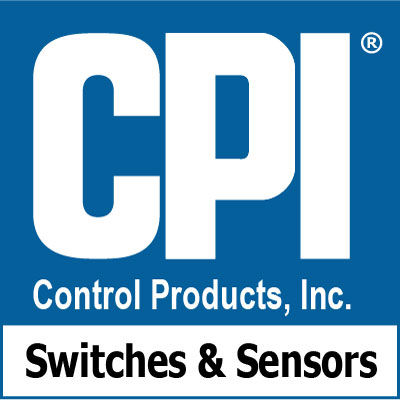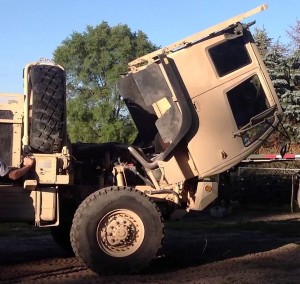There are a number of technologies to choose from when considering the implementation of a linear position sensor. As CPI’s own sensors focus on the needs of designers of hydraulic cylinders and hydraulic accumulators, it is instructive to review the various technologies being used in this market and the relative tradeoff’s of each, as compared to CPI’s LVDT based Linear Position Sensors.
LVDT based Linear Position Sensors (Traditional)
LVDT’s (Linear Variable Differential Transformers) use magnetic induction to determine position and thus are a completely non-contacting sensor solution. They contain coils wound around a coil form through which a high permeability Nickel-Iron core passes, which is attached to the moving member. Piston displacements generate both a phase angle and differential voltage which are used to infer the direction and displacement of the piston. Signal conditioning and support electronics convert this output to DC voltage or current for ease of integration with control systems. LVDT’s can be engineered with special sealed packaging for industrial and aerospace applications allowing for extreme reliability, high precision and extended temperature range. Disadvantages can include feasibility for measuring large displacements, and cost has historically been higher due to the complexity of production and the support electronics. Modern layer winding techniques and low cost ASIC’s have in recent years however allowed cost
reductions. These solutions can cost effectively displace potentiometer and traditional magnetostrictive solutions in many applications.
Potentiometer Based Position Sensing
Use of a variable resistor attached mechanically to a slider on the piston is one of the cheapest and most conceptually simple detection mechanism’s there is. A large variable resistor is used with a “wiper” attached to the moving piston. This is a contact based solution requiring real friction between the wiper and the variable resistive element.
Potentiometer based position sensing’s primary issue is its reliance on mechanical contact to provide feedback that causes output signal degradation over time especially in vibration environments. As MTBF are short in a rugged environment, their applications are limited to moisture free, moderate temperature environments where there are smaller stroke lengths and low cost is a primary design consideration.
Magnetostrictive Linear Position Sensors
These position sensors represent the dominant solution for cylinder position sensing in use today. Magnetostriction is a property of a ferromagnetic waveguide, which twists in the presence of a magnetic field, affecting the time for a pulse to travel from one end of the waveguide to the magnet. LPS’s using this technology take advantage of this property to create a non-contacting solution to the problem of linear position detection. The solution is known for being highly accurate and suitable for relatively long measurement ranges (6-120 in). Inherent in this solution is the use of a waveguide (the “rod”) which must run the length of the cylinder and requires core drilling of the cylinder for insertion.
With magnetostrictive sensors, sagging can be an issue for longer strokes. Additionally the rods are susceptible to vibration which can cause bending and misalignment which requires them to be replaced. And finally the technology has “dead zones” at the cylinder limits which can be minimized, but not eliminated.
Hybrid Solutions, CPI Linear Position Sensor
As one of the newest hydraulic cylinder / piston accumulator position sensor technologies, CPI’s SL series sensors fit in the class of draw wire sensors but replace the traditional core sensor with a patented sealed LVDT implementation for reliable position measurement in harsh environments. Using a unique linear to rotary to linear mechanism the LVDT can detect displacement at the spool on either the oil or the gas side of the piston. Using an LVDT that is completely vented, this combination yields a solution that is immune to high pressures, as well as shock, vibration, magnetic field interference and has an extended operating temperature range up to 125C.
While being easy to field retrofit the overall system has high MTBF and accuracy. CPI’s SL series LVDT based Linear Position Sensors are used in accumulators and long stroke hydraulic cylinders where harsh operating environments must be tolerated.
Another significant advantage of the CPI sensor is that a single part number can replace sensors in cylinders of widely varying stroke lengths. No more needing to stock a replacement rod sensor in every single length, now one or two part numbers cover them all.
Draw Wire Sensors
Using a highly flexible steel cable, a spring loaded spool, and a sensor mechanism of some type, Draw-wire displacement sensors measure linear movements. The cable drum is attached to the sensor element which provides a proportional output signal. Without the use of centered linear alignment, draw wire sensors can measure linear position with high accuracy. They can be configured for wet, dirty or high vibration outdoor environments and applications, and provide installation flexibility. Weaknesses relate more to the sensor mechanism employed, typically a potentiometer (hence the term “string pot) or an optical encoder.
Optical Encoders
Optical encoders read optical gratings that are decoded to offer either relative or absolute position. High end devices can offer up to 18 bits of resolution whereas low cost versions provide resolutions of 10-12 bits. These devices can determine speed, position and direction with extreme accuracy. In order to operate however, these sensors require more complex support electronics and are generally suitable for labs and indoor applications where their relative fragility and high cost can be tolerated.
About CPI Linear Position Sensors
CPI has been producing state of the art linear position sensors since 1997. Our current models represent the most evolved solution to position measurement around. They are deployed throughout the world in Marine, Ocean Drilling, Mobile hydraulics, and mining applications where only the toughest solutions will do.
Visit our website to learn more at: http://www.cpi-nj.com/


